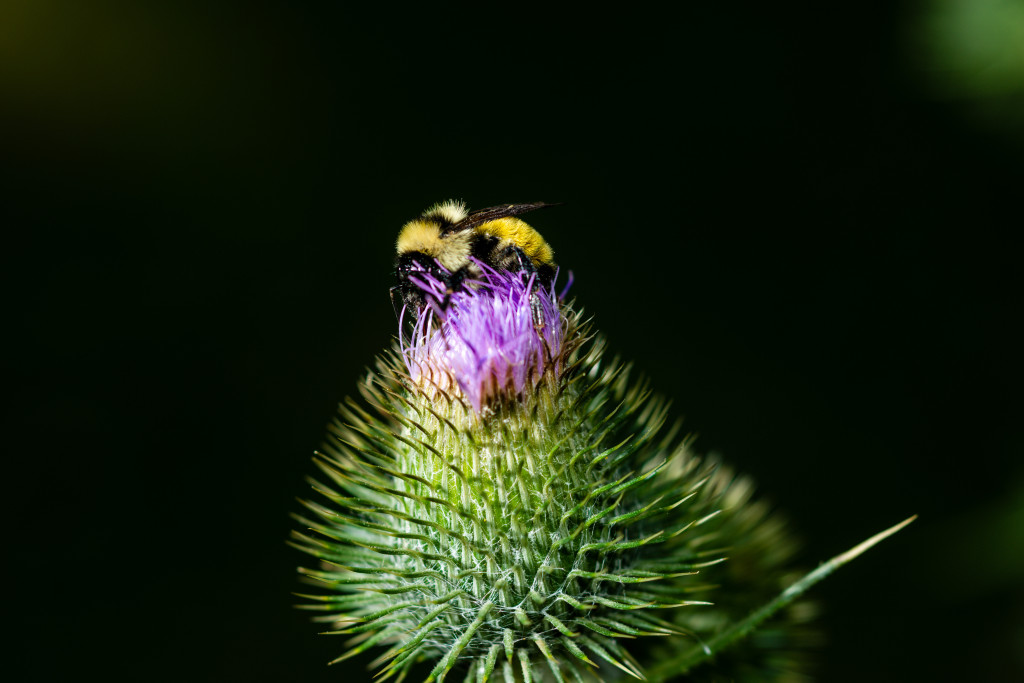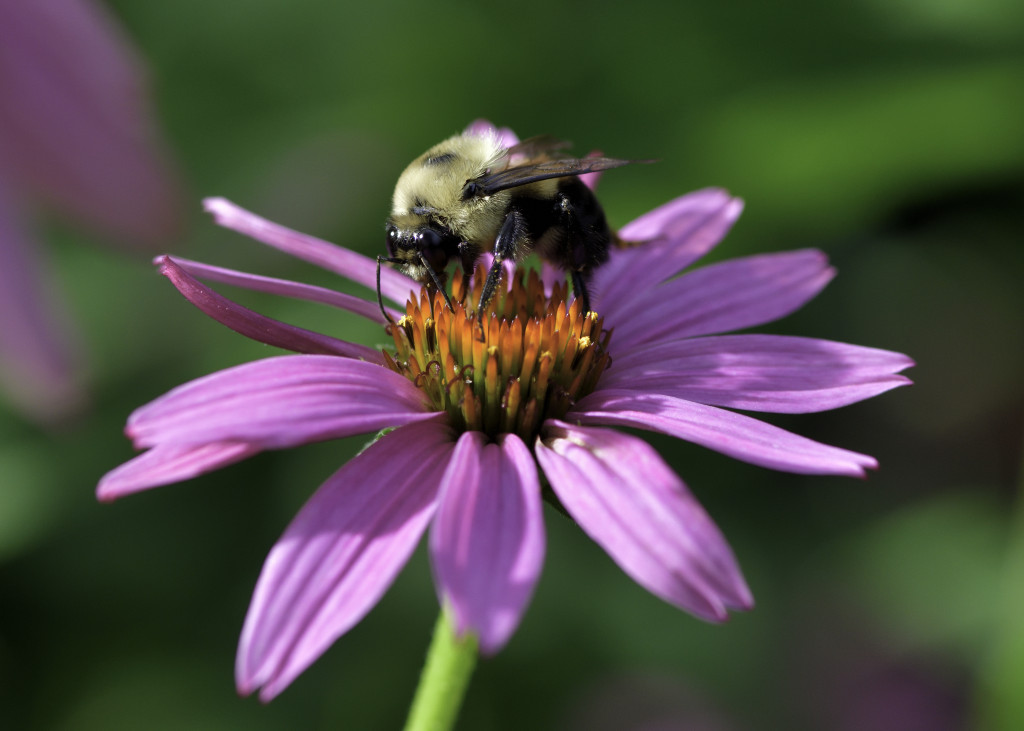Enlarge

By Monica Macoubrie, Wildlife Education Specialist
I grew up believing that the western honey bee (Apis mellifera), also called European honey bee, was the god of all bees. Now as an adult, I see things differently. Sure, the species is crucial to the production of honey and a central money maker in agriculture, but let’s face it: The western honey bee is essentially cows with wings. And because they are a domesticated species, almost all of their genes have been manipulated by humans rather than by nature. So, with that established, let’s pivot our bee talk toward more interesting native bees.
Bees are divided into two categories depending on their lifestyle: solitary or social. If you do a quick image search for bees, you will most likely see those living in a hive. These are social bees, and in Nebraska, the western honey bee is the only species that uses a hive. Another recognizable species is the bumblebee, which is also social, but its “hive” is actually referred to as a nest. True social bees share a nest and divide the work within their colony. They care for offspring and forage for pollen and nectar. Social bees have developed a caste system, and the ranking of each individual bee is determined mostly by the diet it received during development. Normally, worker bees will feed larvae royal jelly and then switch to something less nutrient rich called bee bread. Those bees that are destined to become queens, however, will feed on royal jelly only throughout their entire larval development.

While most of us recognize social bees, what’s surprising is that most pollinating species of bees are actually solitary. These bees don’t resemble the hive-dwelling colonies we typically associate with bees. Here’s the main difference: Female solitary bees make their own nests and get their own supplies without the help of an entire colony. Although you might see many solitary bees sharing a nest, they are only grouping in large numbers because a particular nesting site is so good. Solitary bees can then be divided up into two smaller groups: the wood nesters and the ground nesters. Wood nesters make up around 30 percent of our native bee species. These insects will either tunnel into rotting logs above ground or use old holes made by wood boring beetles, or the soft pithy centers of twigs or reeds. Seventy percent of native bees nest underground. These bees will tunnel straight into the soil and create small chambers, or brood cells, under the surface.
So, now that you know the distinction between the different types of native bees, let’s look at a few species that you may see in our state.
Large Carpenter Bees – These bees often get confused with bumble bees due to their similar markings. But if you look closely, you’ll notice that large carpenter bees have relatively hairless abdomens, whereas true bumble bees are “fuzzy.” Like their name suggests, these bees are skilled wood workers. The females will tunnel along the grain of untreated wood to dig their nests, where she will feed growing larvae the nectar and pollen they need to grow. How do you know if you have carpenter bees? Look for perfectly circular holes in untreated wood that are around ½-inch in diameter.
Cuckoo Bees – These insects are some of the most wasp-looking bees you will find in Nebraska. Also, don’t worry if you can’t tell the different between a wasp, bee or hornet — even experts have trouble differentiating. Cuckoo bees vary in color depending on the species. They can be black and yellow, black and red, have bands or not have bands — their markings vary greatly. Cuckoo bees fall into the bumble bee category of bees. They get their name from their parasitic behavior. Female cuckoo bees will enter the nest of another bee and change out the other female bee’s eggs with hers. Then she will cover her tracks by pushing dirt over the opening to make it look like she was never there. The nest’s true owner is none the wiser.
Mason Bees – Mason bees are an extremely diverse group of bees, and just in North American alone, there are around 139 species. All species are known to be solitary and are excellent pollinators, especially for commercial crops. To build their nests, most species of mason bees will chew leaf pulp and use that substance to construct cells, or tiny compartments in their nests, and to cap the entrance to their nests. Other species have been known to use mud, sand or plant fibers. Mason bee nests have been reported in living trees, abandoned wasp nests, under bark, underground, in hollow reeds and stems and even snail shells. This group of bees is also known to have a higher percentage of at-risk species than even bumble bees.
Sweat Bees – Outside of honey bees and bumble bees, sweat bees might be the next most observed and identifiable group of bees. These bees don’t make honey, but they have extremely fine bristles on their bodies to collect pollen. Just like their name implies, these bees have an affinity for salt — often the perspiration on a person’s arms, legs and neck. Be careful, because female sweat bees are known to sting if brushed or agitated. Usually after the bee gets its fill of salt mineral, they will fly off. These bees are known to pollinate a variety of urban plants and can be found in backyard gardens, open fields and parks.
Bumble bees – I can’t write a bee article without mentioning bumble bees. As mentioned before, Nebraska has 20 species of bumble bees alone. Four of those species are identified as Species of Greatest Conservation Need, and they are the western bumble bee, southern plains bumble bee, suckle cuckoo bumble bee and the variable cuckoo bumble bee. These types of bees encompass every bee stereotype: They buzz, they are large in size, and they have those distinctive yellow and black (sometimes orange) color patterns. If you are interested in bumble bees, check out the Nebraska Bumble Bee Atlas. It is a statewide community science project aimed at tracking and conserving Nebraska’s native bumble bees. https://www.nebraskabumblebeeatlas.org/ ■

The post Get Your Buzz On appeared first on Nebraskaland Magazine.
















